Synthesis and Solvent Dependent Fluorescence of Some Piperidine-Substituted Naphthalimide Derivatives and Consequences for Water Sensing
Abstract
:1. Introduction
2. Results and Discussion
3. Materials and Methods
3.1. Materials
3.2. General Procedure for the Synthesis of 2-(4-Methyl-5-oxo-2,5-dihydrofuran-2-yloxy)-6-(4-methylpiperidin-1-yl)-benzo[de]isoquinoline-1,3-dione (7) and 2-(4-Methyl-5-oxo-2,5-dihydrofuran-2-yloxy)-6-(4-benzyl-piperidin-1-yl)-benzo[de]isoquinoline-1,3-dione (8)
3.3. Characterization Data
3.3.1. 2-(4-Methyl-5-oxo-2,5-dihydrofuran-2-yloxy)-6-(4-methylpiperidin-1-yl)-benzo[de]isoquinoline-1,3-dione (7)
3.3.2. 2-(4-Methyl-5-oxo-2,5-dihydro-furan-2-yloxy)-6-(4-benzyl-piperidin-1-yl)-benzo[de]isoquinoline-1,3-dione (8)
3.4. Methods
4. Conclusions
Supplementary Materials
Author Contributions
Funding
Institutional Review Board Statement
Informed Consent Statement
Data Availability Statement
Conflicts of Interest
References
- Gudeika, D. A review of investigation on 4-substituted 1,8-naphthalimide derivatives. Synth. Met. 2020, 262, 116328. [Google Scholar] [CrossRef]
- Saito, G.; Velluto, D.; Resmini, M.T. Synthesis of 1,8-naphthalimide-based probes with fluorescent switch triggered by flufenamic acid. Royal Soc. Open Sci. 2018, 5, 172137. [Google Scholar] [CrossRef] [PubMed] [Green Version]
- Marinova, N.V.; Georgiev, N.I.; Bojinov, V.B. Facile synthesis sensor activity and logic behavior of 4-aryloxy substituted 1,8-naphthalimide. J. Photochem. Photobiol. A Chem. 2013, 254, 54–61. [Google Scholar] [CrossRef]
- Mati, S.S.; Chall, S.; Rakshit, S.; Bhattacharya, S.C. Spectroscopic and quantum mechanical approach of solvatochromic immobilization: Modulation of electronic structure and excited-state properties of 1,8-naphthalimide derivative. J. Fluoresc. 2015, 25, 341–353. [Google Scholar] [CrossRef] [PubMed]
- Miao, L.; Yao, Y.; Yang, F.; Wang, Z.; Li, W.; Hu, J. TDDFT and PCM-TDDFT studies on absorption spectra of N-substituted 18-naphthalimides dyes. J. Mol. Struct. Theochem. 2008, 865, 79–87. [Google Scholar] [CrossRef]
- Banerjee, S.; Veale, E.B.; Phelan, C.M.; Murphy, S.A.; Tocci, G.M.; Gillespie, L.J.; Frimannsson, D.O.; Kelly, J.M.; Gunnlangson, T. Recent advances in the development of 1,8-naphthalimides based DNA targeting binders anticancer and fluorescent cellular imaging agents. Chem. Soc. Rev. 2013, 42, 1601−1618. [Google Scholar] [CrossRef] [Green Version]
- Noirbent, G.; Dumur, F. Recent advances on naphthalic anhydrides and 1,8-naphthalimide-based photoinitiators of polymerization. Eur. Polym. J. 2020, 132, 109702. [Google Scholar] [CrossRef]
- Fedorova, O.A.; Arkhipova, A.N.; Panchenko, P.A.; Berthet, J.; Delbaere, S.; Minkovska, S.; Fedorov, Y.V. Fluorescent photochromic complex of 1,8-naphthalimide derivative and benzopyrane containing benzo-18-crown-6 ether. J. Photochem. Photobiol. A 2021, 405, 112975. [Google Scholar] [CrossRef]
- Bekere, L.; Gachet, D.; Lokshin, V.; Marine, W.; Khodorkovsky, V. Synthesis and spectroscopic properties of 4-amino-1,8-naphthalimide derivatives involving the carboxylic group: A new molecular probe for ZnO nanoparticles with unusual fluorescence features. Beilstein J. Org. Chem. 2013, 9, 1311–1318. [Google Scholar] [CrossRef]
- Saini, A.; Thomas, K.R.J.; Huang, Y.J.; Ho, K.C. Synthesis and characterization of naphthalimide-based dyes for dye sensitized solar cells. J. Mater. Sci. Mater. Electron. 2018, 29, 16565–16580. [Google Scholar] [CrossRef]
- Meng, Z.; Yang, L.; Yao, C.; Li, H.; Fu, Y.; Wang, K.; Qu, Z.; Wang, Z. Development of naphthalimide-based fluorescent probe for imaging monoamine oxidase A in living cells and zebrafish. Dye. Pigm. 2020, 176, 108208. [Google Scholar] [CrossRef]
- Ni, J.Y.; Weng, X.F.; Sun, R.; Xu, Y.J.; Ge, J.F. Convenient construction of fluorescent markers for lipid droplets with 1,8-naphthalimide unit. Dye. Pigm. 2021, 186, 109003. [Google Scholar] [CrossRef]
- Fu, Y.; Pang, X.X.; Wang, Z.Q.; Qu, H.T.; Ye, F. Synthesis and fluorescent property study of novel 1,8-naphthalimide-based chemosensors. Molecules 2018, 23, 376. [Google Scholar] [CrossRef] [PubMed] [Green Version]
- Xu, Z.; Luo, Y.; Hong, Y.; Liu, Z.; Zhang, M.X.; Gu, S.X.; Yin, J. A naphthimide-based radiometric fluorescent probe for selective and visual detection of phosgene in solution and the gas phase. Spectrochim. Acta Part A 2022, 269, 120789. [Google Scholar] [CrossRef] [PubMed]
- Ulla, H.; Garudachari, B.; Satyanarayan, M.N.; Umesh, G.; Isloor, A.M. Blue organic light emitting materials: Synthesis and characterization of novel 1,8-naphthalimide derivatives. Opt. Mater. 2014, 36, 704–711. [Google Scholar] [CrossRef]
- Bardajee, G.R.; Li, A.Y.; Haley, J.C.; Winnik, M.A. The synthesis and spectroscopic properties of novel, functional fluorescent naphthalimide dyes. Dye. Pigm. 2008, 79, 24–32. [Google Scholar] [CrossRef]
- Magalhaes, J.L.; Pereira, R.V.; Triboni, E.R.; Berci-Filho, P.; Gehlen, M.H.; Nart, F.C. Solvent effect on the photophysical properties of 4-phenoxy-N-methyl-1,8-naphthalimide. J. Photochem. Photobiol. A Chem. 2006, 183, 165–170. [Google Scholar] [CrossRef]
- Staneva, D.; Vasileva-Tonkova, E.; Grozdanov, P.; Vilhelmova-Ilieva, N.; Nikolova, I.; Grabchev, I. Synthesis and photophysical characterization of 3-bromo-4-dimethylamino-1,8-naphthalimides and their evaluation as agents for antibacterial and photodynamic therapy. J. Photochem. Photobiol. A Chem. 2020, 401, 112730. [Google Scholar] [CrossRef]
- Zhang, Y.; Qu, Y.; Wu, J.; Rui, Y.; Gao, Y.; Wu, Y. Naphthalimide end-capping molecular rotors with different donor cores: Tuning emission in wide gamut and cell imaging. Dye. Pigm. 2020, 179, 108431. [Google Scholar] [CrossRef]
- Dhar, S.; Roy, S.S.; Rana, D.K.; Bhattacharya, S.; Bhattacharya, S.; Bhattacharya, S.C. Tunable solvatochromic response of newly synthesized antioxidative naphthalimide derivatives: Intramolecular charge transfer associated with hydrogen bonding effect. J. Phys. Chem. A 2011, 115, 2216−2224. [Google Scholar] [CrossRef]
- Middleton, R.W.; Parrick, J.; Clarke, E.D.; Wardman, P. Synthesis and fluorescence of N-substituted-1,8-naphthalimides. J. Heterocyclic Chem. 1986, 23, 849–855. [Google Scholar] [CrossRef]
- Hladysh, S.; Murmiliak, A.; Vohlidal, J.; Zednik, J. Attachment of a 1,8-naphthalimide moiety to a conjugated polythiophene efficiently improves the sensing abilities of naphthalimide-based material. Macromol. Chem. Phys. 2020, 220, 1800436. [Google Scholar] [CrossRef]
- Bahta, M.; Ahmed, N. A novel 1,8-naphthalimide as highly selective naked-eye and ratiometric fluorescent sensor for detection of Hg2+ ions. J. Photochem. Photobiol. A Chem. 2019, 373, 154–161. [Google Scholar] [CrossRef]
- Liang, S.; Tong, Q.; Qin, X.; Liao, Q.; Li, X.; Yan, G. A hydrophilic naphthalimide-based fluorescence chemosensor for Cu2+ ion: Sensing properties, cell imaging and molecular logic behavior. Spectrochim. Acta A Mol. Biomol. Spectrosc. 2020, 230, 118029. [Google Scholar] [CrossRef] [PubMed]
- Zhang, L.; Zhang, F.; Ding, L.; Gao, J. Reusable colorimetric and fluorescent chemosensors based on 1,8-naphthalimide derivatives for fluoride ion detection. Spectrochim. Acta A Mol. Biomol. Spectrosc. 2020, 237, 118395. [Google Scholar] [CrossRef] [PubMed]
- Jiao, C.; Liu, Y.; Lu, W.; Zhang, P.; Ma, X.; Wang, Y. A simple sensor based on 1,8-naphthalimide with large Stokes shift for detection Y of hydrochlorous acid in living cells. RSC Adv. 2019, 9, 31196–31201. [Google Scholar] [CrossRef] [Green Version]
- Griesbeck, A.G.; Ongel, B.; Atar, M. New phthalimide-methionine dyad-based fluorescence probes for reactive oxygen species: Singlet oxygen, hydrogen peroxide, and hypochlorite. J. Phys. Org. Chem. 2017, 30, e3741. [Google Scholar] [CrossRef] [Green Version]
- Shiraishi, Y.; Yamada, C.; Takagi, S.; Hirai, T. Fluorometric and colorimetric detection of hydrochlorous acid and hypochlorite by a naphthalimide-dicyanoisophorone derivative. J. Photochem. Photobiol. A Chem. 2021, 406, 112997. [Google Scholar] [CrossRef]
- Zhang, Y.; Zhang, L. A novel “turn-on” fluorescent probe based on hydroxy functionalized naphthalimide as a logic platform for visual recognition of H2S in environment and living cells. Spectrochim. Acta A Mol. Biomol. Spectrosc. 2020, 235, 118331. [Google Scholar] [CrossRef]
- Li, K.B.; Qu, W.B.; Shen, Q.; Zhang, S.; Shi, W.; Dong, L.; Han, D.M. 1,8-naphthalimide based dual-response fluorescent probe for highly discriminating detection of cys and H2S. Dye. Pigm. 2020, 173, 107918. [Google Scholar] [CrossRef]
- Yuan, W.; Zhong, X.; Han, Q.; Jiang, Y.; Shen, J.; Wang, B. A novel formaldehyde fluorescent probe based on 1,8-naphthalimide derivative and its application in living cell. J. Photochem. Photobiol. A Chem. 2020, 400, 112701. [Google Scholar] [CrossRef]
- Huang, Y.L.; Ye, W.; Su, Y.T.; Wu, Z.Y.; Zheng, H. A naphthalimide-based probe for phosgene sensing based on the phosgene-induced Beckmann rearrangement. Dye. Pigm. 2020, 173, 107854. [Google Scholar] [CrossRef]
- Saha, S.; Samanta, A. Influence of the structure of the amino group and polarity of the medium on the photophysical behavior of 4-amino-1,8-naphthalimide derivatives. J. Phys. Chem. A 2002, 106, 4763–4771. [Google Scholar] [CrossRef]
- Akshaya, K.B.; Varghese, A.; Lobo, P.L.; Kumari, R.; George, L. Synthesis and photophysical properties of a novel phthalimide derivative using solvatochromic shift method for the estimation of ground and singlet excited state dipole moments. J. Mol. Liq. 2016, 224, 247–254. [Google Scholar] [CrossRef]
- Li, Z.; Yang, Q.; Chang, R.; Ma, G.; Chen, M.; Zhang, W. N-heteroaryl-1,8-naphthalimide fluorescent sensor for water: Molecular design, synthesis and properties. Dye. Pigm. 2011, 88, 307−314. [Google Scholar] [CrossRef]
- Niu, C.G.; Qin, P.Z.; Zeng, G.M.; Gui, X.Q.; Guan, A.L. Fluorescence sensor for water in organic solvents prepared from covalent immobilization of 4-morpholinyl-1,8-naphthalimide. Anal. Bioanal. Chem. 2007, 387, 1067–1074. [Google Scholar] [CrossRef]
- Park, H.; Chang, S.K. Signaling of water content in organic solvents by solvatochromism of a hydroxynaphthalimide-based merocyanine dye. Dye. Pigm. 2015, 122, 324–330. [Google Scholar] [CrossRef]
- Kumar, A.; Hor, W.; Seong, G.H.; Chae, P.S. Sensitive detection of DMSO/DMF in water, human urine and blood plasma using novel 1,8-naphthalimide-based amphiphilic spectroscopic probes. Dye. Pigm. 2021, 189, 19240. [Google Scholar] [CrossRef]
- Li, N.N.; Liu, W.; Shi, N.N.; Yang, D.; Zong, Z.; Zhang, X.; Wu, R.X.; Xu, C.G.; Bi, S.Y.; Fan, Y.H. Multiple naphthalimide dimers polymorphs triggered solvatochromism, solid-state emission and aggregation-induced emission by different interaction and its application in fluorescence ratiometric sensing of dichloromethane and 1,4-dioxane. Dye. Pigm. 2021, 188, 109172. [Google Scholar] [CrossRef]
- Oancea, F.; Georgescu, E.; Matusova, R.; Georgescu, F.; Nicolescu, A.; Raut, I.; Jecu, M.L.; Vladulescu, M.C.; Vladulescu, L.; Deleanu, C. New strigolactone mimics as exogenous signals for rhizosphere organisms. Molecules 2017, 22, 961. [Google Scholar] [CrossRef]
- Cook, C.E.; Whichard, L.P.; Turner, B.; Wall, M.E.; Egley, G.H. Germination of witchweed (Striga lutea Lour.): Isolation and properties of a potent stimulant. Science 1966, 154, 1189–1190. [Google Scholar] [CrossRef] [PubMed]
- Matusova, R.; Rani, K.; Verstappen, F.W.A.; Franssen, M.C.R.; Beale, M.H.; Bouwmeester, H.J. The strigolactone germination stimulants of the plant-parasitic Striga and Orobanche spp. are derived from the carotenoid pathway. Plant Physiol. 2005, 139, 920–934. [Google Scholar] [CrossRef] [PubMed] [Green Version]
- Akiyama, K.; Matsuzaki, K.I.; Hayashi, H. Plant sesquiterpenes induce hyphal branching in arbuscular mycorrhizal fungi. Nature 2005, 435, 824–827. [Google Scholar] [CrossRef] [PubMed]
- Besserer, A.; Puech-Pagès, V.; Kiefer, P.; Gomez-Roldan, V.; Jauneau, A.; Roy, S.; Portais, J.C.; Roux, C.; Bécard, G.; Séjalon-Delmas, N. Strigolactones stimulate arbuscular mycorrhizal fungi by activating mitochondria. PLoS Biol. 2006, 4, 1239–1247. [Google Scholar] [CrossRef]
- Umehara, M.; Hanada, A.; Yoshida, S.; Akiyama, K.; Arite, T.; Takeda-Kamiya, N.; Magome, H.; Kamiya, Y.; Shirasu, K.; Yoneyama, K.; et al. Inhibition of shoot branching by new terpenoid plant hormones. Nature 2008, 455, 195–200. [Google Scholar] [CrossRef] [PubMed]
- Rameau, C.; Goormachtig, S.; Cardinale, F.; Tom Bennett, T.; Cubas, P. Strigolactones as Plant Hormones. In Strigolactones—Biology and Applications; Koltai, H., Prandi, C., Eds.; Springer Nature: Cham, Switzeland, 2019; pp. 47–87. [Google Scholar]
- Nicolescu, A.; Airinei, A.; Georgescu, E.; Georgescu, F.; Tigoianu, R.; Oancea, F.; Deleanu, C. Synthesis, photophysical properties and solvatochromic analysis of some naphthalene-1,8-dicarboxylic acid derivatives. J. Mol. Liq. 2020, 303, 112626. [Google Scholar] [CrossRef]
- Demets, G.J.F.; Triboni, E.R.; Alvarez, E.B.; Arantes, G.M.; Filho, P.B.; Politi, M.J. Solvent influence on the photophysical properties of 4-methoxy-N-methyl-1,8-naphthalimide. Spectrochim. Acta Part A 2006, 63, 220–226. [Google Scholar] [CrossRef]
- Georgiev, N.I.; Marinova, N.V.; Bojinov, V.B. Design and synthesis of light-harvesting rotor based on 1,8-naphthalimide units. J. Photochem. Photobiol. A Chem. 2020, 401, 112733. [Google Scholar] [CrossRef]
- Marinova, N.V.; Georgiev, N.I.; Bojinov, V.B. Synthesis and photophysical properties of novel 1,8-naphthalimide light-harvesting antennae based on benzyl aryl ether architecture. J. Luminesc. 2018, 204, 253–260. [Google Scholar] [CrossRef]
- Terenin, A. Photonics of Dyes Molecules and Related Organic Compounds; Nauka: Saint Petersburg, Russia, 1967. (In Russian) [Google Scholar]
- Wen, G.T.; Zhu, M.Z.; Wang, Z.; Meng, X.M.; Hu, H.Y.; Guo, Q.X. Studies on the transition metal ion induced fluorescence enhancement of 1,8-naphthalimide derivatives. Chin. J. Chem. 2006, 24, 1230–1237. [Google Scholar] [CrossRef]
- Poteau, X.; Brown, A.I.; Brown, R.G.; Holmes, C.; Matthew, D. Fluorescence switching in 4-amino-1,8-naphthalimides: “on-off-on” operation controlled by solvent and cations. Dye. Pigm. 2000, 47, 91–105. [Google Scholar] [CrossRef]
- Reichardt, C. Solvents and Solvent Effects in Organic Chemistry, 3rd ed.; Wiley-VCH: Weinheim, Germany, 2003. [Google Scholar]
- Olutas, M.; Sagirli, A. Solvatochromic and solid-state emissive azlactone-based AIEE-active organic dye: Synthesis, photophysical properties and color-conversion LED application. J. Mol. Liq. 2020, 313, 113482. [Google Scholar] [CrossRef]
- Lippert, E. Spektroskopische Bestimmung des Dipolmomentes aromatischer Verbidungen im ersten angeregten Singulettzustand. Z. Elektrochem. Ber. Bunsenges. Phys. Chem. 1957, 61, 962–975. [Google Scholar] [CrossRef]
- Mataga, N.; Kaifu, Y.; Koizumi, M. Solvent effects upon fluorescence spectra and the dipolmoments of excited molecules. Bull. Chem. Soc. Jpn. 1956, 29, 465–470. [Google Scholar] [CrossRef] [Green Version]
- Bakhshiev, N.G. Spectroscopy of Intermolecular Interactions; Nauka: Saint Petersburg, Russia, 1972. (In Russian) [Google Scholar]
- Catalan, J.; Hopf, H. Empirical treatment of inductive and dispersive components of solute-solvent interactions: The polarizability solvent scale. Eur. J. Org. Chem. 2004, 2004, 4694–4702. [Google Scholar] [CrossRef]
- Catalan, J. Toward a generalized treatment of the solvent effect on flow empirical scales: Dipolarity (SdP, a new scale), polarizability (SP), acidity (SA) and basicity (SB) of the medium. J. Phys. Chem. B 2009, 113, 5951–5960. [Google Scholar] [CrossRef]
- Kamlet, M.J.; Abboud, J.L.; Taft, R.W. The solvatochromic comparison method. 6. The π* scale of solvent polarities. J. Am. Chem. Soc. 1977, 90, 6027–6038. [Google Scholar] [CrossRef]
- Kamlet, M.J.; Abboud, J.L.M.; Taft, R.W. An examination of linear solvation energy relationships. Progr. Phys. Org. Chem. 1981, 13, 485–630. [Google Scholar] [CrossRef]
- Kamlet, M.J.; Abboud, J.L.; Abraham, M.H.; Taft, R. Linear solvation energy relationships. 23. A comprehensive collection of the solvatochromic parameters, π*, α and β, and some methods for simplifying the generalized solvatochromic method. J. Organomet. Chem. 1983, 48, 2877–2887. [Google Scholar] [CrossRef]
- Airinei, A.; Rusu, E.; Dorohoi, D. Solvent influence on the electronic absorption spectra of some azoaromatic compounds. Spectrosc. Lett. 2000, 34, 65–74. [Google Scholar] [CrossRef]
- Rusu, E.; Dorohoi, D.O.; Airinei, A. Solvatochromic effects in the absorption spectra of some azobenzene compounds. J. Mol. Struct. 2008, 887, 216–219. [Google Scholar] [CrossRef]
- Marcus, Y. The properties of organic liquids that are relevant to their use as solvating solvents. Chem. Soc. Rev. 1993, 22, 409–416. [Google Scholar] [CrossRef]
- Han, F.; Chi, L.; Wu, W.; Liang, X.; Fu, M.; Zhao, J. Environment sensitive phenothiazine dyes strongly fluorescence in protic solvents. J. Photochem. Photobiol. A Chem. 2008, 196, 10–23. [Google Scholar] [CrossRef]
- Lakowicz, J.R. Principles of Fluorescence Spectroscopy, 3rd ed.; Springer: New York, NY, USA, 2006. [Google Scholar]
- Gehlen, M.H. The centenary of the Stern-Volmer equation of fluorescence quenching: From the single line plot to the SV quenching map. J. Photochem. Photobiol. C Photochem. Rev. 2020, 42, 100338. [Google Scholar] [CrossRef]
- Airinei, A.; Tigoianu, R.I.; Rusu, E.; Dorohoi, D.O. Fluorescence quenching of anthracene by nitroaromatic compounds. Dig. J. Nanostruct. Biostruct. 2011, 6, 1265–1272. [Google Scholar]
- Ciotta, E.; Prosposito, P.; Pizzoferrato, R. Positive curvature in Stern-Volmer plot described by a generalized model for static quenching. J. Luminesc. 2019, 206, 518–522. [Google Scholar] [CrossRef]
- Kournoutas, F.; Kalis, I.K.; Feckova, M.; Achelle, S.; Fakis, M. The effect of protonation on the excited state dynamics of pyrimidine chromophores. J. Photochem. Photobiol. A Chem. 2020, 391, 112398. [Google Scholar] [CrossRef]
- Wang, J.T.; Pei, Y.Y.; Ren, S.F.; Yan, M.Y.; Luo, W.; Zhang, B.; Li, Q.F. Two 8-hydroxyquinoline-based fluorescent chemosensors for ultra-fast ans sensitive detection of water in strong polar organic solvents with large Stokes shifts. Spectrochim. Acta A Mol. Biomol. Spectrosc. 2020, 229, 117956. [Google Scholar] [CrossRef]
- MacAlpine, G.A.; Raphael, R.A.; Shaw, A.; Taylor, A.W.; Wild, H.J. Synthesis of the germination stimulant (±)-strigol. J. Chem. Soc. Perkin Trans. 1976, 1, 410–416. [Google Scholar] [CrossRef]
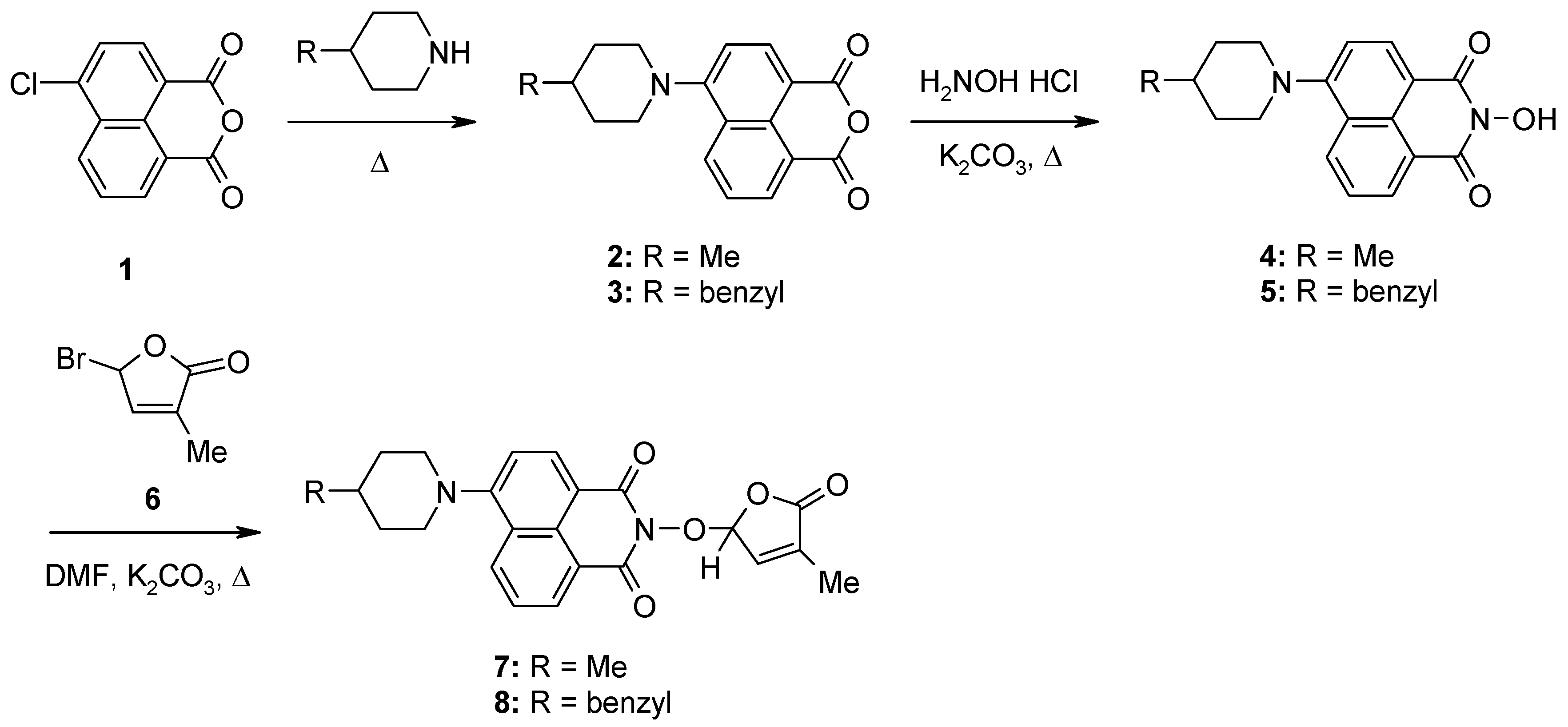
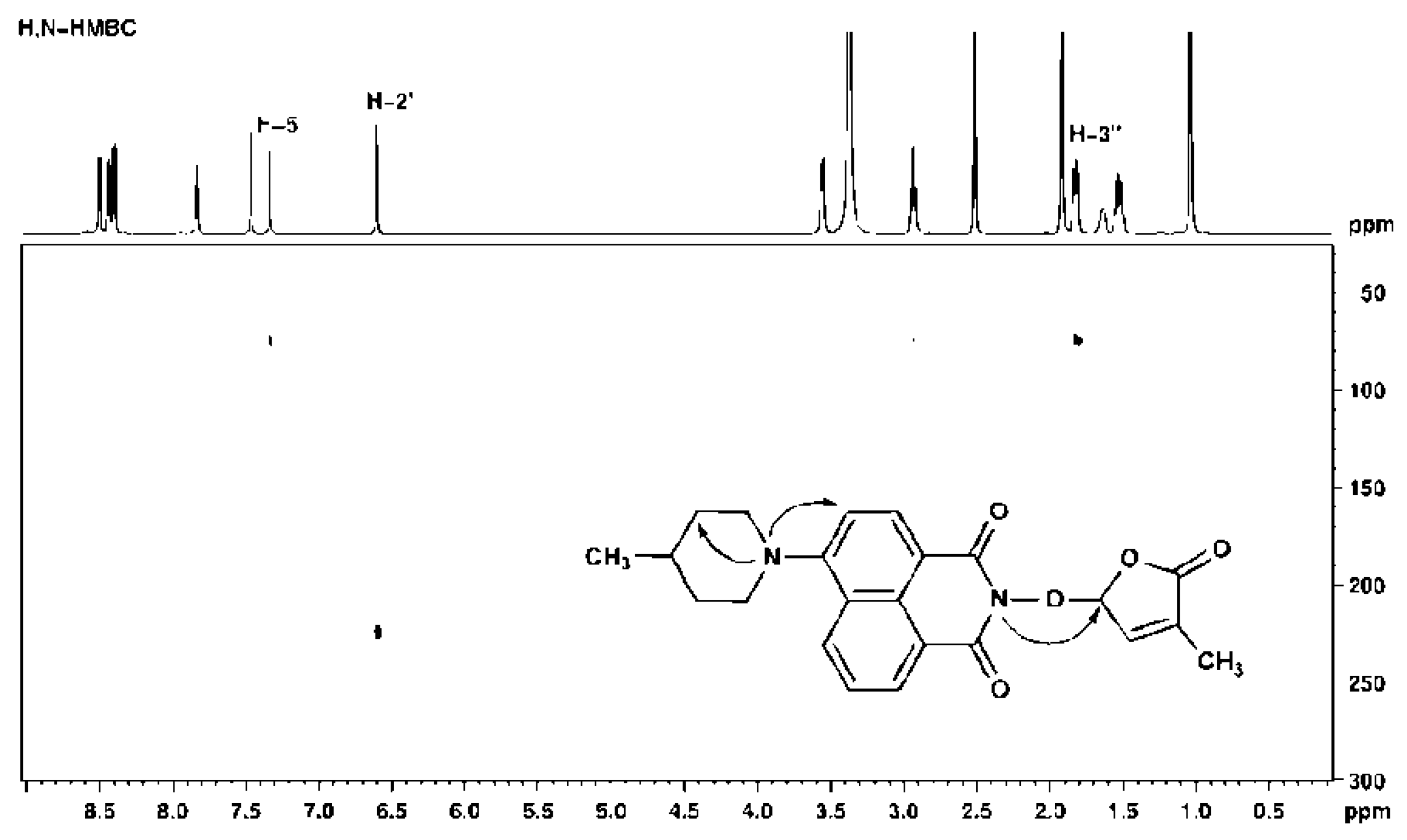
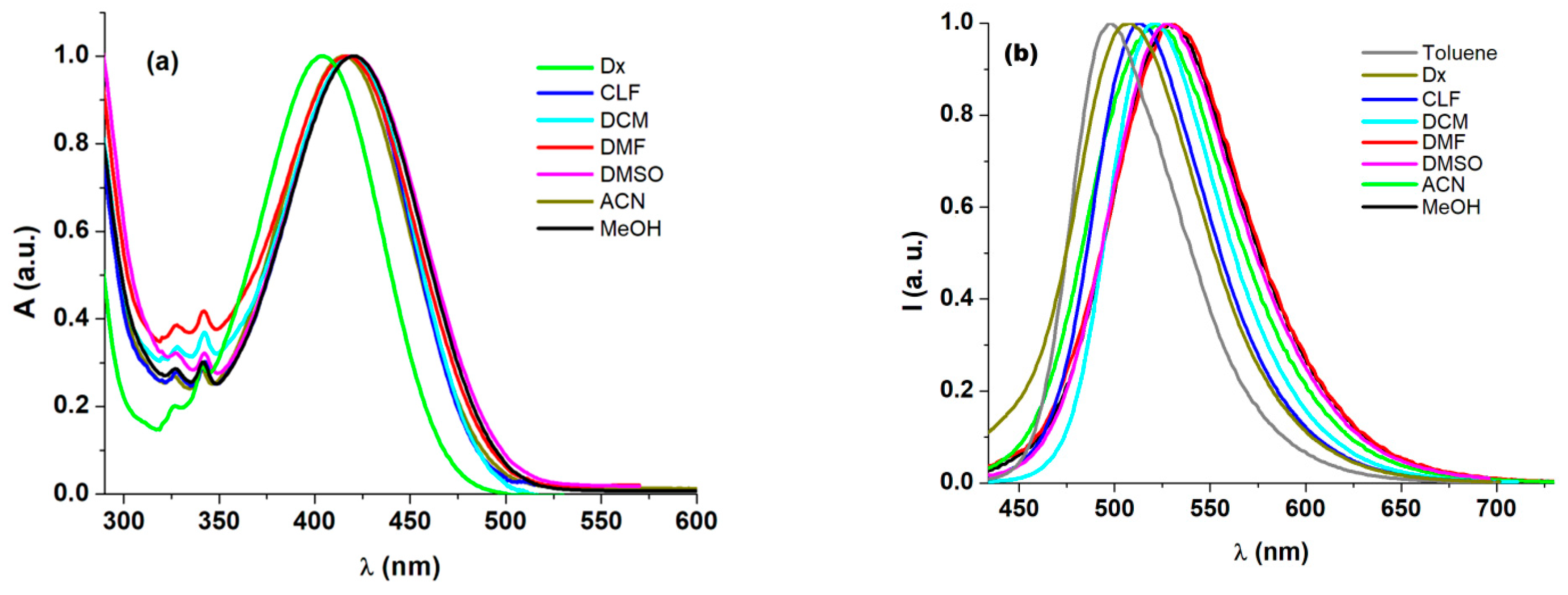
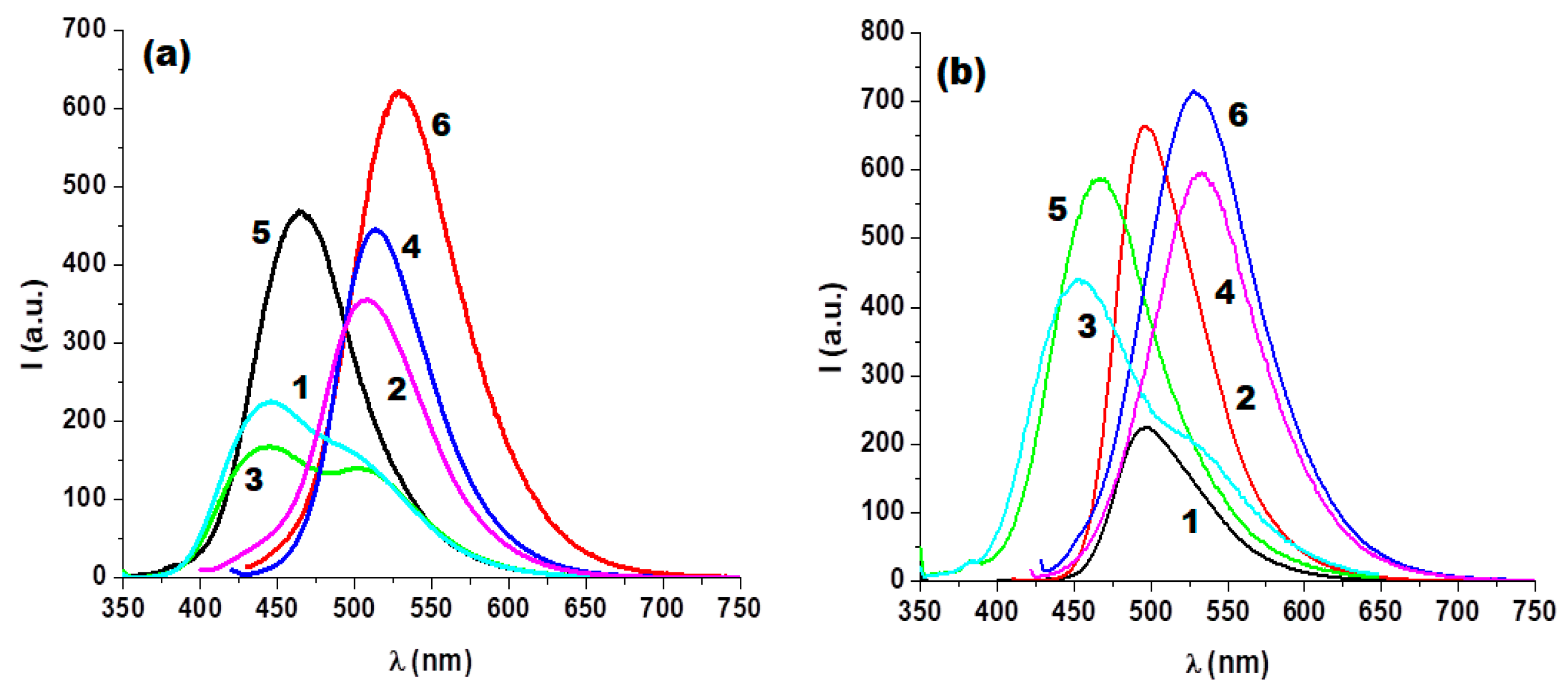
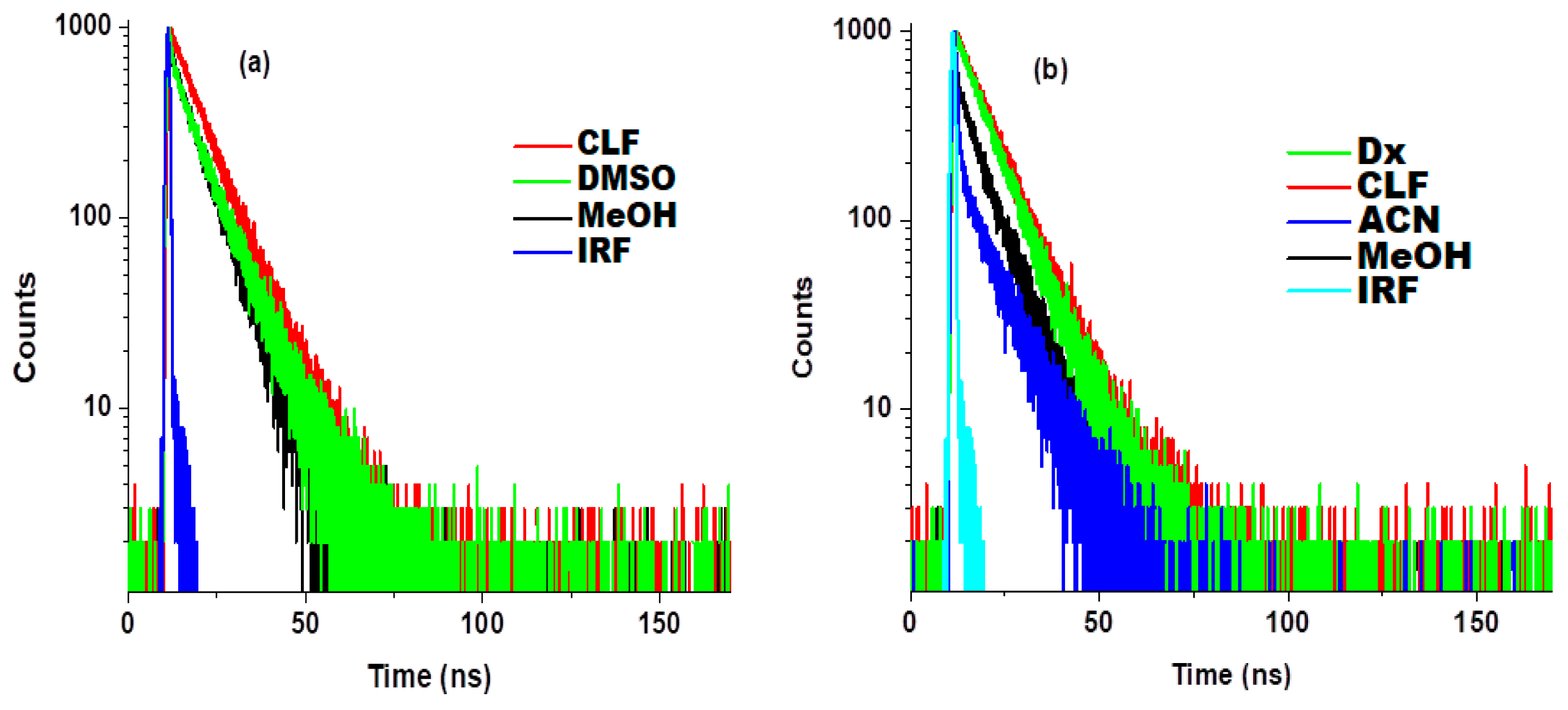
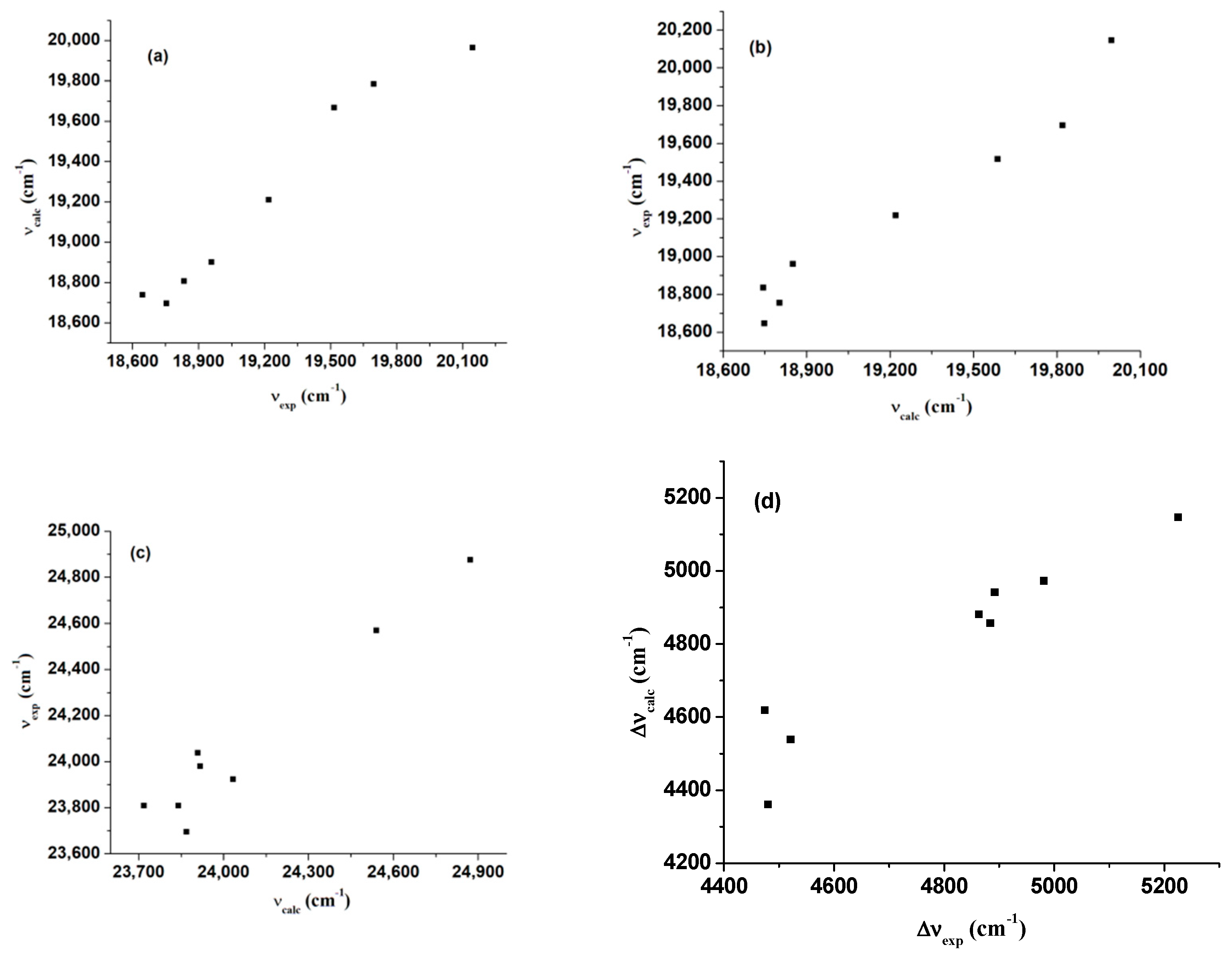
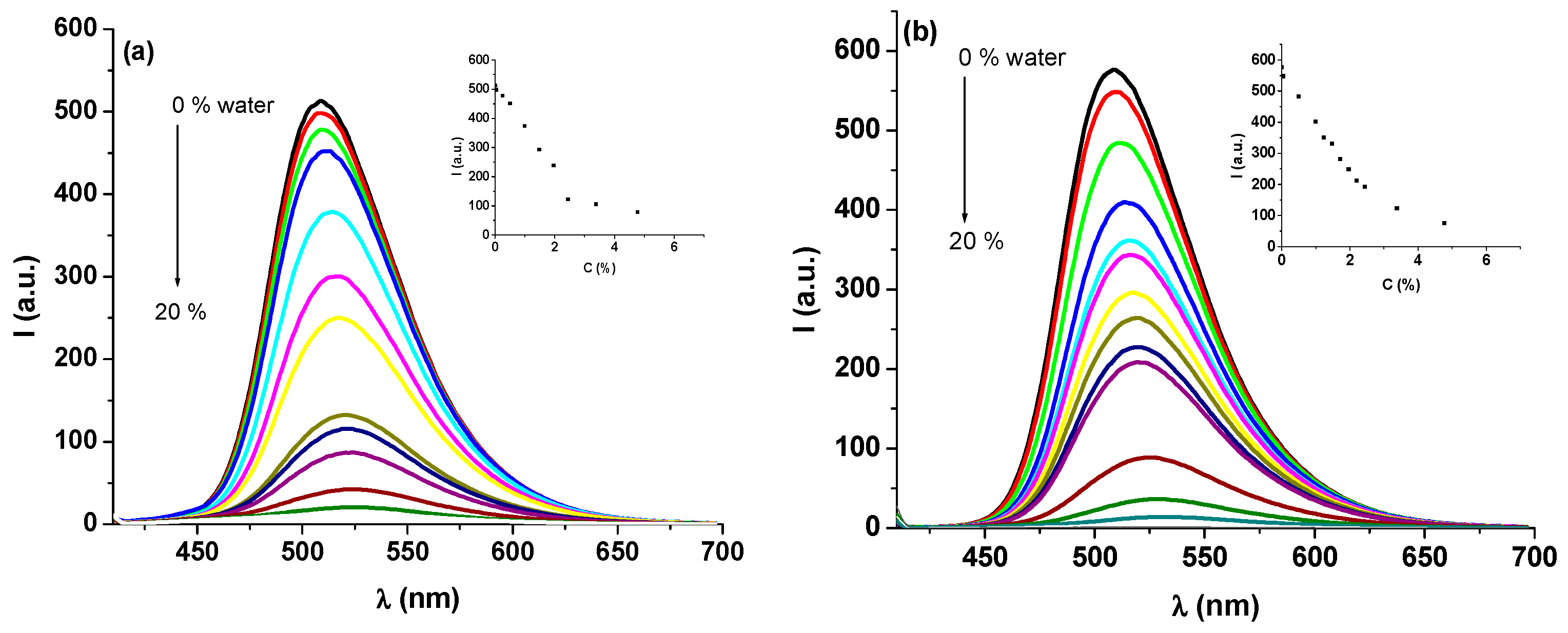
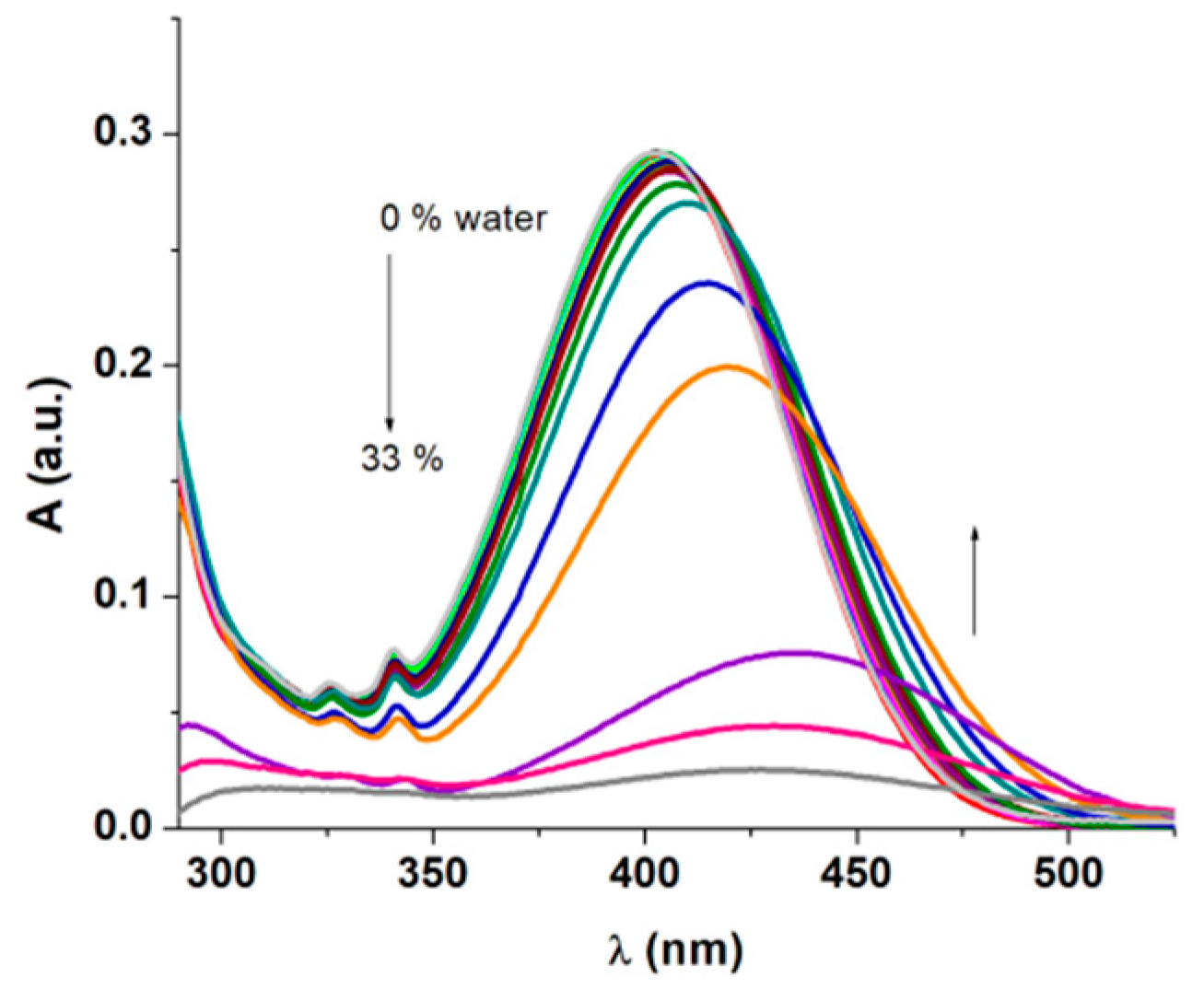
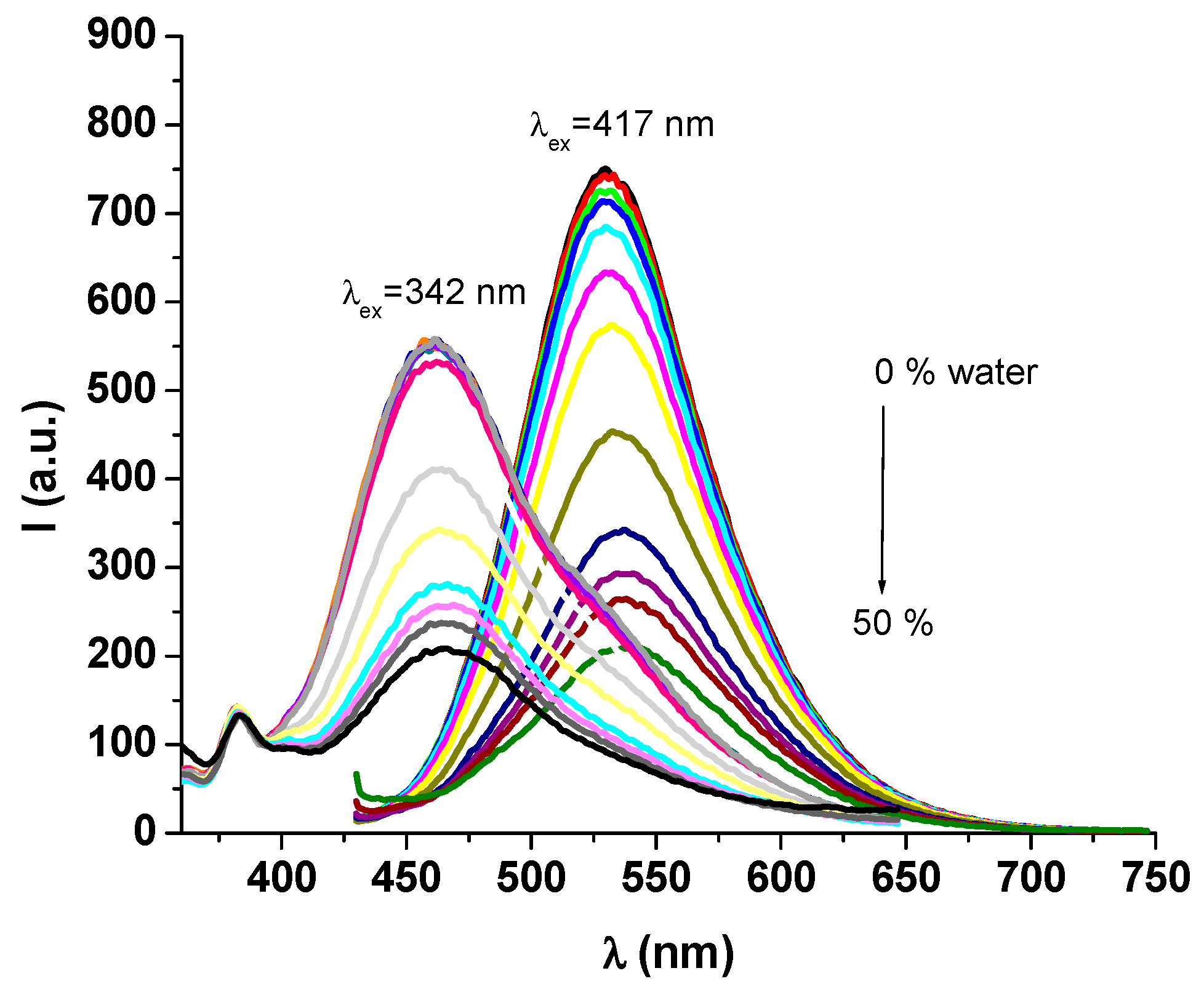
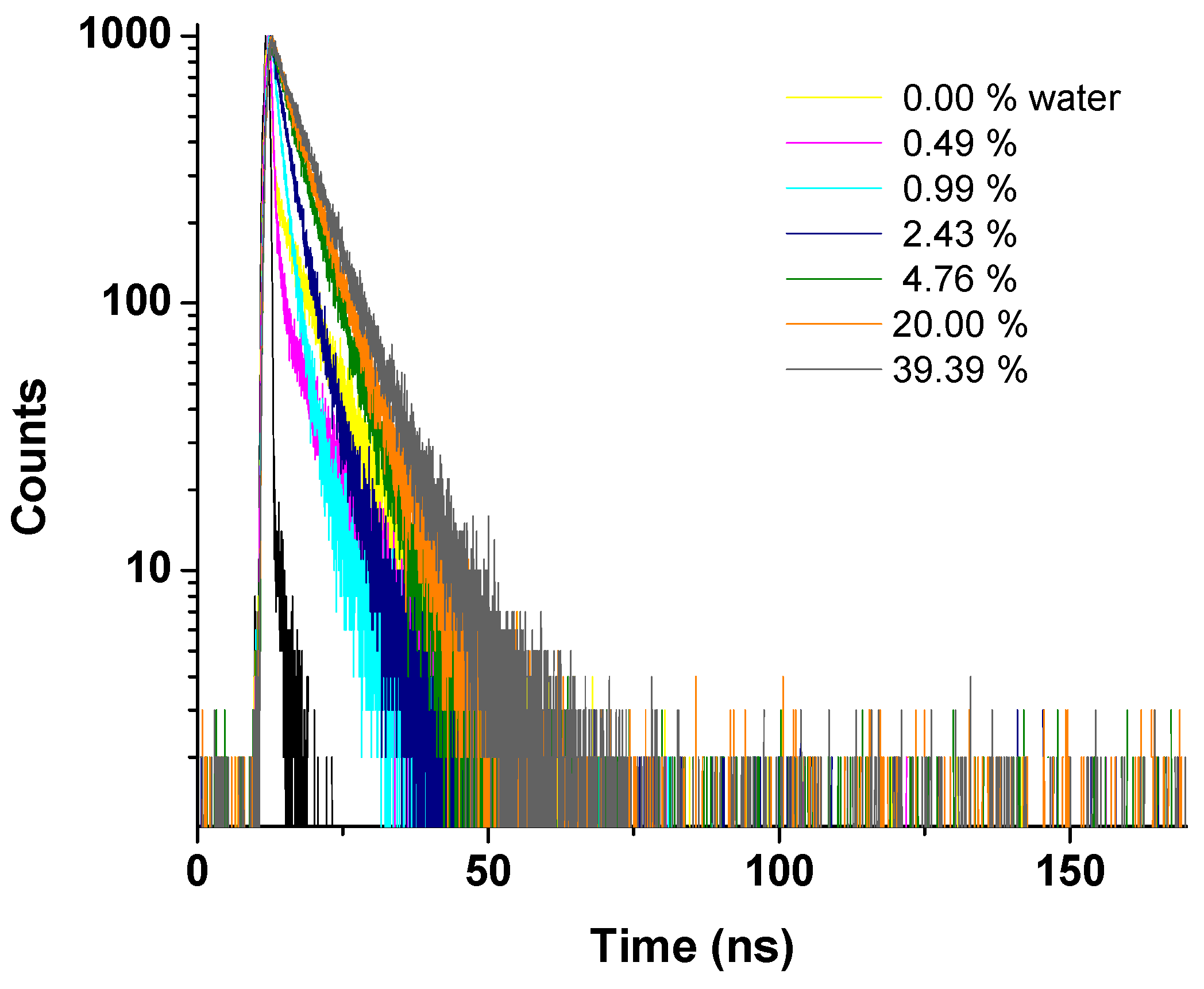
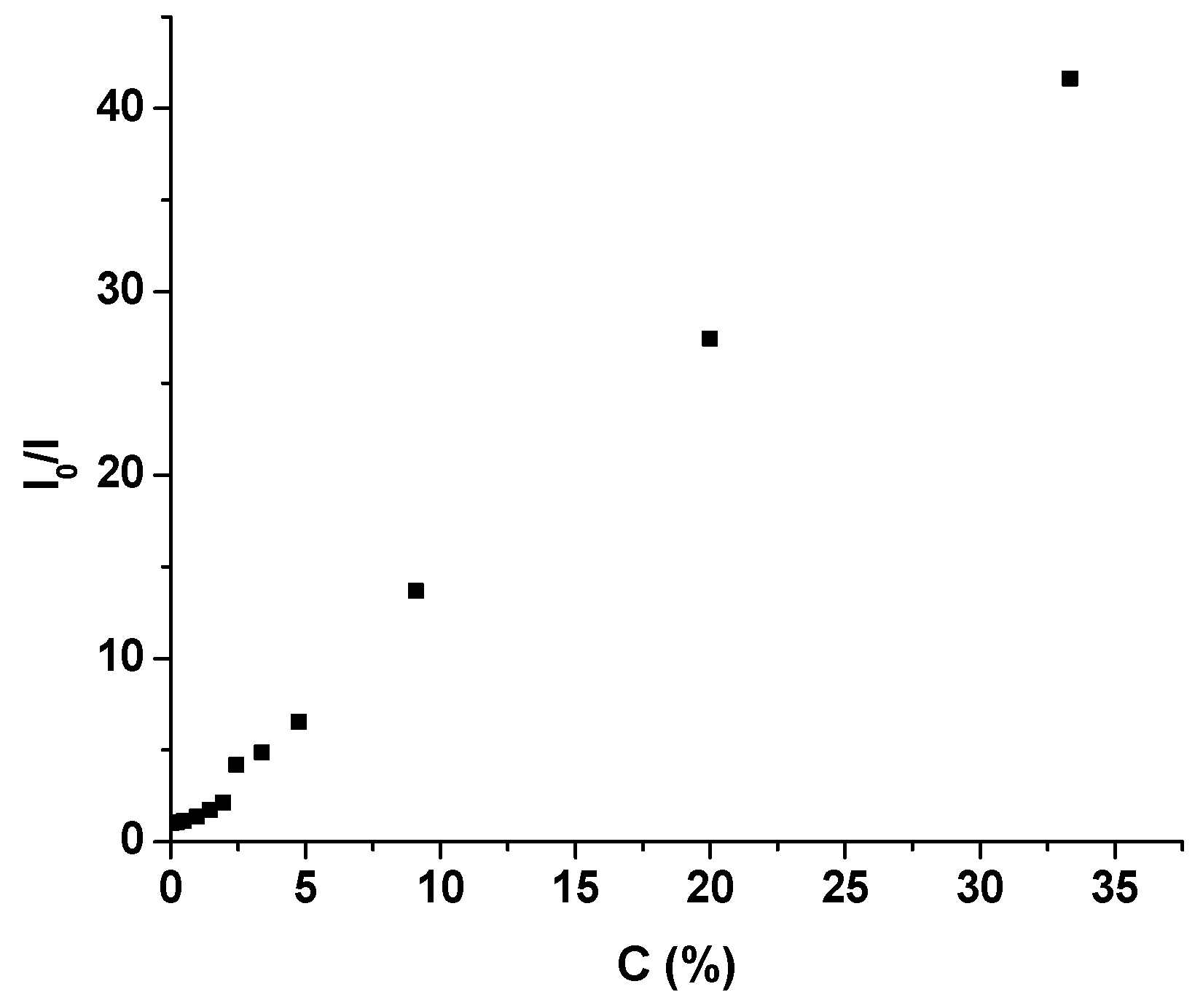

| Solvent | ET(30) | 7 | 8 | ||||||
|---|---|---|---|---|---|---|---|---|---|
| νa (cm−1) | νf (cm−1) | Δν (cm−1) | Φ | νa (cm−1) | νf (cm−1) | Δν (cm−1) | Φ | ||
| Toluene | 33.9 | 24,570 | 20,096 | 4474 | 0.546 | 24,691 | 20,145 | 4546 | 0.453 |
| Dioxane | 36.0 | 24,785 | 19,650 | 5225 | 0.821 | 24,875 | 19,696 | 5179 | 0.875 |
| Chloroform | 39.1 | 23,980 | 19,500 | 4480 | 0.686 | 23,980 | 19,516 | 4464 | 0.726 |
| DCM | 40.7 | 23,696 | 19,175 | 4521 | 0.451 | 23,752 | 19,219 | 4533 | 0.529 |
| DMF | 43.2 | 23,923 | 18,942 | 4981 | 0.214 | 23,923 | 18,646 | 5277 | 0.064 |
| DMSO | 45.1 | 23,809 | 18,925 | 4884 | 0.015 | 23,809 | 18,835 | 4974 | 0.003 |
| Acetonitrile | 45.6 | 24,038 | 19,175 | 4863 | 0.106 | 24,154 | 18,754 | 5400 | 0.017 |
| Methanol | 55.4 | 23,809 | 18,917 | 4892 | 0.082 | 23,866 | 18,960 | 4906 | 0.081 |
| Solvent | 7 | 8 | ||||
|---|---|---|---|---|---|---|
| kr(×10−7) (s−1) | knr(×10−7) (s−1) | EF | kr(×10−7) (s−1) | knr(×10−7) (s−1) | EF | |
| Toluene | 6.86 | 5.70 | 0.447 | 5.84 | 7.06 | 0.369 |
| Dioxane | 10.15 | 2.21 | 0.648 | 10.87 | 1.55 | 0.673 |
| DCM | 5.39 | 6.57 | 0.366 | 6.28 | 5.58 | 0.426 |
| DMF | 2.46 | 9.02 | 0.171 | 0.75 | 12.39 | 0.049 |
| DMSO | 0.17 | 11.29 | 0.012 | 0.38 | 11.92 | 0.002 |
| Acetonitrile | 1.17 | 9.85 | 0.085 | 0.20 | 10.31 | 0.013 |
| Methanol | 1.07 | 12.01 | 0.065 | 1.11 | 12.66 | 0.065 |
| Solvent | 7 | 8 | ||||||
|---|---|---|---|---|---|---|---|---|
| τ1 (ns)/a1(%) | τ2(ns)/a2(%) | χ2 | τav (ns) | τ1(ns)/a1(%) | τ2(ns)/a2(%) | χ2 | τav (ns) | |
| Toluene | 7.96 (100) | 0.99 | 7.96 | 7.75 (100) | 1.00 | 7.75 | ||
| Dioxane | 8.09 (100) | 1.00 | 8.09 | 8.05 (100) | 1.00 | 8.05 | ||
| Chloroform | 8.69 (100) | 1.00 | 8.69 | 8.49 (100) | 1.00 | 8.49 | ||
| DCM | 8.36 (100) | 1.00 | 8.36 | 8.43 (100) | 1.00 | 8.43 | ||
| DMF | 0.55 (7.93) | 8.76 (92.07) | 0.99 | 8.71 | 0.21 (41.46) | 7.75 (58.54) | 1.00 | 7.61 |
| DMSO | 0.85 (10.00) | 8.80 (90.00) | 1.00 | 8.72 | 0.36 (21.68) | 8.23 (78.32) | 1.00 | 8.13 |
| Acetonitrile | 0.81 (10.43) | 9.17 (89.57) | 1.00 | 9.08 | 0.44 (40.32) | 8.36 (59.68) | 1.00 | 8.08 |
| Methanol | 7.68 (93.51) | 0.56 (6.49) | 1.00 | 7.65 | 0.26 (14.04) | 7.29 (85.96) | 1.00 | 7.26 |
| No. | Solvent | n | π* | SP | SdP | SB | SA | ET(30) | |||
|---|---|---|---|---|---|---|---|---|---|---|---|
| 1. | Toluene | 2.38 | 1.4969 | 0.54 | 0.11 | 0.00 | 0.782 | 0.284 | 0.128 | 0.000 | 33.9 |
| 2. | Dioxane | 2.22 | 1.4224 | 0.49 | 0.37 | 0.00 | 0.737 | 0.312 | 0.444 | 0.000 | 36.0 |
| 3. | Chloroform | 4.81 | 1.4459 | 0.58 | 0.00 | 0.44 | 0.783 | 0.614 | 0.071 | 0.947 | 39.1 |
| 4. | DCM | 9.08 | 1.4242 | 0.73 | 0.10 | 0.13 | 0.761 | 0.769 | 0.178 | 0.040 | 40.7 |
| 5. | DMF | 38.25 | 1.4305 | 0.87 | 0.69 | 0.00 | 0.759 | 0.977 | 0.613 | 0.031 | 43.2 |
| 6. | DMSO | 47.24 | 1.4470 | 1.00 | 0.76 | 0.00 | 0.830 | 1.000 | 0.647 | 0.072 | 45.1 |
| 7. | Acetonitrile | 37.50 | 1.3442 | 0.75 | 0.31 | 0.19 | 0.645 | 0.974 | 0.286 | 0.044 | 45.6 |
| 8. | Methanol | 33.00 | 1.3288 | 0.60 | 0.62 | 0.93 | 0.608 | 0.904 | 0.545 | 0.605 | 55.4 |
| Sample | y0 (cm−1) | SP | SdP | SB | SA | R2 | |
|---|---|---|---|---|---|---|---|
| νa | 7 | 25,728 | −988 | −1456 | 554 | −234 | 0.93 |
| 8 | 26,111 | −1353 | −1399 | 328 | −336 | 0.94 | |
| νf | 7 | 20,204 | 161 | −1095 | −539 | −138 | 0.96 |
| 8 | 20,048 | 552 | −1547 | −342 | 86 | 0.98 | |
| Δν | 7 | 5525 | −1150 | −360 | 1094 | 96 | 0.88 |
| 8 | 6072 | −1932 | 117 | 727 | −401 | 0.82 | |
| Sample | ν0 (cm−1) | π* | β | α | R2 | |
|---|---|---|---|---|---|---|
| νa | 7 | 25,985 | −2826 | 736 | −973 | 0.96 |
| 8 | 26,048 | −2823 | 669 | −959 | 0.95 | |
| νf | 7 | 20,801 | −1791 | −308 | −688 | 0.92 |
| 8 | 21,090 | −2323 | −321 | −640 | 0.88 | |
| Δν | 7 | 5184 | −1036 | 1044 | −285 | 0.85 |
| 8 | 4959 | −500 | 989 | −318 | 0.69 | |
| Sample | ν0 (cm−1) | c1 | c2 | c3 | c4 | R2 | |
|---|---|---|---|---|---|---|---|
| νa | 7 | 26,851 | −1834 | −6358 | 609 | −460 | 0.97 |
| 8 | 27,111 | −1815 | −7100 | 518 | −498 | 0.95 | |
| νf | 7 | 20,040 | −1146 | 741 | −309 | −66 | 0.94 |
| 8 | 19,218 | −1563 | 4317 | −216 | 395 | 0.97 | |
| Δν | 7 | 6812 | −688 | −7099 | 918 | −394 | 0.95 |
| 8 | 7894 | −252 | −11,418 | 734 | −893 | 0.95 | |
| Sample | Water Content (%) | τ1 (ns)/a1 (%) | τ2 (ns)/a2 (%) | τav (ns) | χ2 |
|---|---|---|---|---|---|
| 7 | 0.00 | 7.24 (100) | 7.24 | 1.00 | |
| 0.49 | 6.58 (100) | 6.58 | 1.00 | ||
| 0.99 | 5.81 (100) | 5.81 | 1.00 | ||
| 2.44 | 2.48 (56.49) | 6.38 (43.51) | 5.08 | 0.81 | |
| 4.76 | 1.46 (62.27) | 7.35 (37.73) | 5.91 | 0.85 | |
| 20.00 | 0.43 (27.67) | 7.76 (72.33) | 7.61 | 0.96 | |
| 39.39 | 0.43 (11.93) | 7.60 (88.07) | 7.54 | 1.00 | |
| 8 | 0.00 | 6.66 (100) | 6.66 | 0.99 | |
| 0.49 | 5.83 (100) | 5.83 | 0.97 | ||
| 0.99 | 5.22 (100) | 5.22 | 0.98 | ||
| 2.44 | 3.50 (100) | 3.50 | 1.00 | ||
| 4.76 | 1.68 (79.79) | 5.80 (20.21) | 3.60 | 0.68 | |
| 20.00 | 0.46 (59.61) | 7.06 (40.30) | 6.47 | 0.75 | |
| 39.39 | 0.26 (34.62) | 7.19 (65.38) | 7.06 | 0.89 |
| Sample | Water Content (%) | τ1 (ns)/a1 (%) | τ2 (ns)/a2 (%) | τav (ns) | χ2 |
|---|---|---|---|---|---|
| 7 | 0.00 | 0.55 (7.93) | 8.76 (92.07) | 8.71 | 0.99 |
| 0.99 | 0.54 (7.49) | 8.67 (92.51) | 8.62 | 1.11 | |
| 4.76 | 0.50 (7.44) | 8.58 (92.56) | 8.53 | 1.05 | |
| 20.00 | 0.94 (6.84) | 8.25 (93.16) | 8.18 | 1.04 | |
| 42.86 | 1.16 (6.59) | 7.93 (93.41) | 7.86 | 1.02 | |
| 50.00 | 1.16 (6.04) | 7.83 (93.96) | 7.77 | 1.01 | |
| 8 | 0.00 | 0.21 (41.46) | 7.75 (58.54) | 7.61 | 1.00 |
| 0.99 | 0.21 (41.03) | 7.78 (58.97) | 7.64 | 1.00 | |
| 4.76 | 0.19 (38.67) | 7.66 (61.33) | 7.54 | 1.15 | |
| 20.00 | 0.20 (32.23) | 7.57 (67.77) | 7.47 | 1.18 | |
| 42.86 | 0.24 (24.03) | 7.22 (75.97) | 7.14 | 1.10 | |
| 50.00 | 0.24 (21.26) | 7.16 (78.74) | 7.09 | 1.11 |
| Solvent | KSV | |
|---|---|---|
| 7 | 8 | |
| Dioxane | 1.367 | 2.132 |
| DMF | 0.031 | 0.036 |
| DMSO | 0.019 | 0.018 |
Publisher’s Note: MDPI stays neutral with regard to jurisdictional claims in published maps and institutional affiliations. |
© 2022 by the authors. Licensee MDPI, Basel, Switzerland. This article is an open access article distributed under the terms and conditions of the Creative Commons Attribution (CC BY) license (https://creativecommons.org/licenses/by/4.0/).
Share and Cite
Tigoianu, R.; Airinei, A.; Georgescu, E.; Nicolescu, A.; Georgescu, F.; Isac, D.L.; Deleanu, C.; Oancea, F. Synthesis and Solvent Dependent Fluorescence of Some Piperidine-Substituted Naphthalimide Derivatives and Consequences for Water Sensing. Int. J. Mol. Sci. 2022, 23, 2760. https://doi.org/10.3390/ijms23052760
Tigoianu R, Airinei A, Georgescu E, Nicolescu A, Georgescu F, Isac DL, Deleanu C, Oancea F. Synthesis and Solvent Dependent Fluorescence of Some Piperidine-Substituted Naphthalimide Derivatives and Consequences for Water Sensing. International Journal of Molecular Sciences. 2022; 23(5):2760. https://doi.org/10.3390/ijms23052760
Chicago/Turabian StyleTigoianu, Radu, Anton Airinei, Emilian Georgescu, Alina Nicolescu, Florentina Georgescu, Dragos Lucian Isac, Calin Deleanu, and Florin Oancea. 2022. "Synthesis and Solvent Dependent Fluorescence of Some Piperidine-Substituted Naphthalimide Derivatives and Consequences for Water Sensing" International Journal of Molecular Sciences 23, no. 5: 2760. https://doi.org/10.3390/ijms23052760
APA StyleTigoianu, R., Airinei, A., Georgescu, E., Nicolescu, A., Georgescu, F., Isac, D. L., Deleanu, C., & Oancea, F. (2022). Synthesis and Solvent Dependent Fluorescence of Some Piperidine-Substituted Naphthalimide Derivatives and Consequences for Water Sensing. International Journal of Molecular Sciences, 23(5), 2760. https://doi.org/10.3390/ijms23052760







